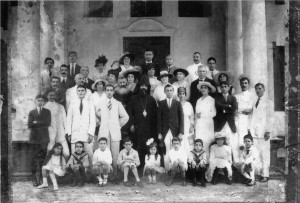[This post includes material later revised and expanded in Double Diaspora in Sephardic Literature: Jewish Cultural Production before and after 1492 (Indiana University Press, 2015)]
‘Double diaspora’ is an idea that I am using to better understand how the experiences of living in diaspora shaped the ways in which Sephardic (Jewish Spanish) writers told stories and sang songs in literary texts from the 13th century to the 16th century.
What is diaspora?
‘Diaspora’ means a lot of things to a lot of people. Most people understand it as a dispersion of a people from their traditional homeland to a bunch of other places. The term was first used to describe the history of the Jews after they were dispersed from Judea/Palestine first by the Babylonians in ca. 600 BCE and then by the Romans in ca. 70 CE. Since then people have used it to describe other groups who experienced similar dispersions: Armenians, Greeks, Indians, Chinese, Africans, and others.
In academic writing, until the last thirty years or so ‘diaspora’ almost always referred to Jewish history, and much of the academic thinking about the idea of diaspora has been shaped by the particulars of the Jewish example: a people unified by a common religion and official language who were expelled forcibly from the land where they were once sovereign.
Diaspora and Galut in Jewish History and Culture

‘He who dispersed me will gather me in,’ from cover of Isaac Cardoso’s ‘Excelencias de los Hebreos’ (Amsterdam, 1679)
In Jewish tradition (as opposed to in histories of Jews written by modern academics), the Rabbis have used the idea of galut (‘exile’) to explain the history of the Jews along prophetic lines. According to this idea, the Jews were exiled from their homeland because it is their destiny, and part of the privileged relationship they enjoy with God, who protects them in their exile among foreign nations. Galut is not just a historical accident, but part of a divine plan. According to some interpretations of galut, the Jews have the task of helping to prepare the world for the arrival of the messiah by performing good works and setting an example for the other nations of the world. It is for this purpose that God dispersed them among the other nations. Once the world is ready, the messiah will arrive and the Jews will be allowed to re-establish their kingdom in Zion (Judea/Palestine).
In modernity, Jewish scholars began to work in both the rabbinate and the university, where this idea needed some retooling. The earliest histories of the Jews written by academics (as opposed to rabbis) looked more or less like other national histories written during the 1800s. But the widespread notion of the Jews’ ‘chosenness’ and the uniqueness of their history (especially in the European and North American Context, where most Jewish historians worked) was difficult to shake completely. As a result, historians (most of them Jewish themselves) continued to treat Jewish history as if it were essentially different from the histories of other peoples and nations. This trend persisted into the second half of the twentieth century, when the establishment of the modern state of Israel forced some rethinking of key issues in Jewish history.
Other diasporas
Historians of other diasporas, especially those that took place in the early modern (ca. 1500-1700) or modern eras, began from a very different starting point. They were pretty clear from the start that God does not make diasporas, people do. Scholars of various modern diasporas, therefore, did not have the same ideological baggage as those working on Jewish history. Working in the 1960s, 1970s, and especially in the 1980s and 1990s, they approached their subject with modern tools in a postmodern world, where people had been theorizing about nationhood, imperialism, political economy, race, gender, class, and many other aspects of human experience. This produced a great amount of scholarship of on a wide array of modern diasporas, including, but not limited to: Armenian, Indian, Sikh, Irish, Chinese, African, Palestinian, and Israeli.
Scholars in the humanities likewise began to approach the literature, film, folklore, and other kinds of cultural production as products of a disasporic culture, that gave voice to the experiences and ideas specific to peoples living in diaspora. Today there is an enormous bibliography on diaspora history and culture (click here to see the first page of results from a search of books.google.com using the keyword ‘diaspora’). Many of these scholars disagree as to what ‘diaspora’ means, which groups qualify as a disapora, and how one should go about discussing the term properly. Accordingly there is a whole subset of scholarship on diaspora that is dedicated to discussion of what the term means and how it should be used.
What’s double diaspora?
Double diaspora is a term that refers to a group that has gone through two successive diasporas. I have seen it applied so far to Indians from Tanzania (who then scatter throughout the anglophone nations of the developed world), to Haitians (diasporic Africans who form a new diaspora as Hatians in France, Canada, and the US), to Israelis (who returned from diaspora to Zion, then scattered again), and to Jamaican Rastafarians (diasporic Africans who then dispersed throughout the Anglophone world – see image above). Other examples continue to emerge.
Sephardic Jews lived for well over 1,000 years in Spain as part of the Ancient Jewish diaspora. After their expulsion from Spain in 1492 they formed a new, second diaspora, throughout the mediterranean and Europe, turning this time both to Zion and to Spain in their imaginations and longing for not one, but two homelands. Double diaspora, Sephardic style.
Why double diaspora for Sephardic literature?
Most studies of Sephardic literature focus on either pre-1492 or post-1492. The concept of double diaspora is a good way to bring the two periods together, one that helps us to maintain continuity while at the same time pay attention to how a new diaspora, from Spain, changes how Sephardic writers worked and wrote. In Spain, Sephardic writers worked around one symbolic homeland, one idea of homeland — Zion. I use the word Zion instead of Judea, Palestine or Israel because that is the biblical name most often used to refer to the symbolic center of the community, the homeland to which one dreamt of returning from somewhere else.
The idea of Zion is a symbolic touchstone that (among many, many other manifestations) lent its name to the Zionist movement, stands at the center of the Rastafarian belief system, and continues to captivate the artistic imagination, for example in 1999 film The Matrix, where in a world overrun by despotic robots, Zion is the last redoubt of humanity.
In the next post I will give a series of specific examples of how the double diaspora of the Sephardim, the twin suns of Zion and Spain, help shape the way in which Sephardic writers tell stories and sing songs.
Bibliography
- Baer, Yitzhak. Galut. New York: Schocken Books, 1947. (the classic study of the question of galut in Jewish philosphy and history)
- Boyarin, D., and J. Boyarin. “Diaspora: Generation and the Ground of Jewish Identity.” Critical Inquiry 19.4 (1993): 693-725. (reassessment of the idea of diaspora in modern Jewry after the establishment of the state of Israel)
- Braziel, Jana, ed. Diaspora: An Introduction. Malden Mass.: Blackwell Pub., 2008. (anthology of key texts and introductory study)
- —, and Anita Mannur. Theorizing Diaspora: A Reader. Malden, MA: Blackwell, 2003. (anthology of key texts by academics in the social sciences and humanities)
- Clifford, James. “Diasporas.” Cultural Anthropology 9.3 (1994): 302-338. (assessment of the scholarship of diaspora, focusing on different theoretical understandings by social scientists – Clifford is an anthropologist)
- Cohen, Robin. Global Diasporas: An Introduction. London: University Collge of London Press, 1997. (Taxonomy and overarching theory of the different types of diasporas spanning from Ancient to Modern world)
- Gilroy, Paul. The Black Atlantic: Modernity and Double Consciousness. Cambridge Mass.: Harvard University Press, 1993. (now-classic study of African diaspora in Caribbean and theory of diasporic identity in modernity)
- Hall, Stuart. “Cultural identity and diaspora.” Identity: community, culture, difference. 2nd ed. Ed. Jonathan Rutherford. London: Lawrence & Wishart, 1990. 222-237. (seminal essay on diasporic identity politics)
- Mishra, Sudesh. Diaspora criticism. Edinburgh: Edinburgh University Press, 2006. (comprehensive critical intellectual history of diaspora studies)
- Ray, Jonathan. “New Approaches to the Jewish Diaspora: The Sephardim as a Sub-Ethnic Group.” Jewish Social Studies 15.1 (2008): 10-30. (argues for productive application of recent scholarship on diasporas for understanding 16th century Sephardic society in century following expulsion from Spain)
- Spero, Shubert. Holocaust and Return to Zion: A Study in Jewish Philosophy of History. Hoboken: KTAV, 2000. (Academic expansion of Baer’s Galut with selections from classic texts by Jewish writers on the question of galut from the Middle Ages to Modernity)




Although Nancy Berg’s ‘Exile from Exile: Israeli Writers from Iraq’ examines Babylonian Jews rather than Sephardic jewry, and deals with Twentieth-Century events rather than with the medieval/early modern scope of your study, I think it nonetheless expands the present discussion in productive ways because of its the manner in which it articulates the cultural re-orientation (and disorientation) of doubled diasporic identities.